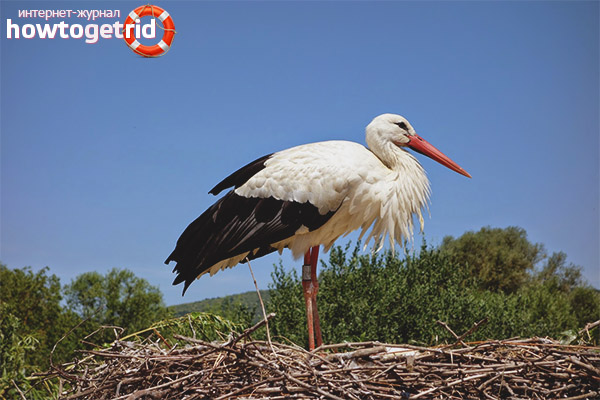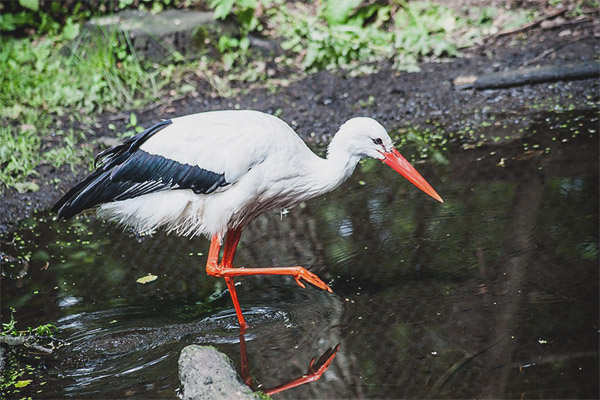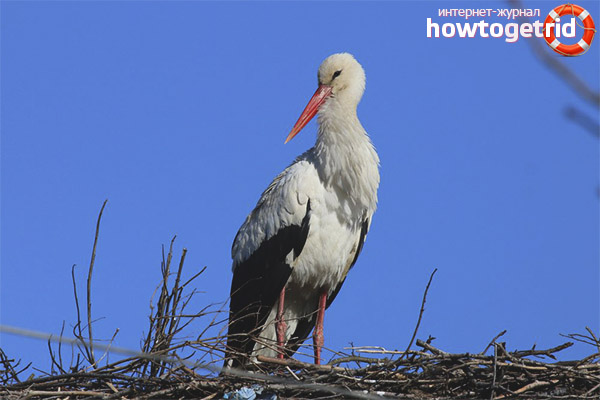The content of the article
Storks are on everyone's lips, people constantly invent fairy tales with the participation of this bird. It also does not do without legends and, of course, explanations of parents in front of the child on the topic “Where do children come from?”. Some attribute the appearance of the baby to the world that he was allegedly brought by a stork. They make verses and sing songs about the bird, they praise it. What is so unusual is present in the representatives of this breed, in addition to the elegant appearance? Let's understand together.
Description
To date, there are more than 12 species of birds of this breed group. Often there are precisely white individuals, which are distinguished by a black border on the wing, as well as a thin beak and long red claws. The bird is famous for its elongated and refined neck, its whole appearance speaks of perfection.
A distinctive feature of these individuals from the sebaceous is considered a proud walk. When the birds fold their wings, they look half dark.There is no sexual dimorphism in terms of coloring, individuals of female and male sex are identical.
As for the mass, storks weigh about 4-5 kg. with a growth of 130 cm. Agree, impressive. Their wingspan reaches 2 m. In size, except that you can identify a female, it is smaller. But this is a dubious venture, many are mistaken.
Describing such a beautiful bird, it is impossible not to affect the cycle of its existence. Individuals of the family under discussion live for about 20 years. There were cases in which the stork lived to 30 years. When a bird exists in captivity, the rates increase. Far Eastern individuals lived to 40-45 years. Birds belong to long-livers, while their relatives, black storks on the water, lived to be 18 years old, and in captivity - to 30 years.
Rhythm of life
When the stork is on its way, it knows the road so well that it can even sleep.Experts have made such a conclusion, because in the process of flight the bird has a pulse and breathing becomes deep. However, the hearing aid works at an accelerated pace, so the individual feels how quickly and where the rest of the fellows in the flock are flying. Roughly speaking, the stork is asleep and at the physiological level follows other birds.
When this family is planning to go for the winter, not one flock of birds gathers, but many. They prefer to spend the winter in Africa; local residents call storks locust eaters. The thing is, they feed on these insects.
In their studies, experts study ringing while observing these individuals. They use satellites, equipping the corps of feathered friends with special transmitters. The signal is transmitted to the satellite, transmitted to scientists, they investigate it. Thanks to this, specialists know for sure what kind of lifestyle the family representatives lead.
Habitat

Stork prefers to settle in Asian and European countries. Since the territories represented are huge in nature, the distribution of birds gradually tapers to the east.
When individuals prepare to spend the winter, they do it in India or Africa.Where winters are relatively warm, storks remain, not flying away. This applies more to Europe and Africa.
When the birds arrive in their usual place for the winter, they immediately try to gather in large flocks. They include more than one thousand birds, so this feature looks impressive.
Young animals are not always sent to spend the winter along with older family members. They can stay because the flight plans to be long. Storks migrate during the day, soar in flight, rising to a decent height. Interestingly, the birds try to avoid areas that are above the sea.
Building nests
Professionals who study behavior and everything related to birds, pay special attention to how they build nests. Before you begin to manipulate, storks will be a long time to monitor people.
Therefore, in ancient times there was a belief that was transferred to the present time. That is, if a nest of this bird appeared, soon there will be a replenishment in the family and a general improvement in the family's condition.
There were cases when, after long observations of people, storks settled directly on the roof of their house.When a person finds a nest, he is not upset at all, believing that he will soon become very happy. Some enthusiasts specially equip the top of the building so that the birds nest there.
Food in nature
By their natural features, these birds feed on vertebrates as well as invertebrate creatures. Vipers, frogs, small fish, lizards, worms, bugs, grasshoppers eat.
Chicks are fed from the beak. Get a meal in the marshy and lowland places. In addition, they feed on rats and mice, moles, and other small birds.
In most cases, represented birds conduct their hunting activity in shallow water. It is worth knowing that storks do not like to go to the depths. Also, birds can eat on land. Birds consume all kinds of insects and freshly cut grass.
In the wild, these individuals often gather in places where people burn grass. In such places you can observe a huge accumulation of various birds. In scorched fields, individuals can eat plenty of insect larvae.
The birds in question have one characteristic feature; they are able to stay in one place for a long time, waiting for prey. Also, storks often feed on small rodents.Birds also wait for the victim near the hole, and then attack.
If birds hunt in troubled waters, they often act at random, as they cannot see anything in such an environment. Storks immerse their beak in water and close it from time to time. As a result, they come across some living creatures.
Such birds are able to catch potential food even on the fly. Storks easily catch various insects and even dragonflies. The undoubted advantage of these birds is that they destroy dangerous insects. Among them should be distinguished beet weevil, beetle-kuzka and bug-bug.
In addition, storks are of great benefit to farmers. Such birds effectively hunt the bear. It is worth noting that an adult needs 0.7 kg. food. What is interesting, when feeding young stock, the amount of food increases significantly. The birds take a whole day looking for food.
Interesting Facts
- It is worth knowing that not all representatives of this species belong to innocuous birds. In Africa, there is a species (marabou). Such storks are predators, besides they feed on carrion.Locals are accustomed to such birds and do not pay attention to them.
- These representatives, who live in the open spaces of Russia, fly away to winter in warm regions. Often their second homeland is India and Africa.
- It is interesting to know that such birds do not feed only on frogs and insects. Storks do an excellent job with venomous snakes. We can say that for them it is even a treat.
- After the birds winter, they return to their habitual nests. Storks in their house begin to restore order. It should be noted that the birds represented are very tied to their homes.
- It is very interesting to know that there was the oldest nest in which not a single generation of storks lived. Birds settled this place for 380 years.
- It is worth noting that during the construction of the nest, it can reach up to 1.5 m in diameter. Moreover, its weight is up to a quarter of a ton. The male stays with the female that first flies to his nest.
- As for breeding, after laying eggs, the pair begins to hatch them one by one. Often, the male spends time in the nest during the day, and the female opposite - at night.
- If the birds nestled in crowded places near houses, the case where the nest caught fire was observed. At the same time, human constructions were burned down. This was due to the fact that storks used more smoldering branches from bonfires to build a nest.
- Storks are pretty cruel to their offspring. If the chicks are weak or sick, parents without any questions will throw them out of the nest. Youngsters learn to fly at the age of two months.
- Separately, it is worth mentioning that only in Japan there is a real law that prohibits stork hunting.
- During flight, the wingspan of an adult individual can reach up to 2 m.
- In Italy, storks were completely destroyed in the 17th century.
- During flights for wintering, these individuals cover a distance of about 10 thousand km.
- Always during rest and sleep, storks stand on one leg. At the same time to change the legs, they do not wake up.
- Often, the birds in question are hunted and attacked by eagles. It is worth noting that it is the white storks who live in Russia the most.
- It is also interesting that when white storks settle, they try to keep closer to the person, black individuals, on the contrary, avoid people.
White storks are a very interesting species of feathered.They have a wayward character. Specifically, these representatives are peace-loving and to some extent help people in agriculture by destroying various insects and pests.
Video: White Stork (Ciconia ciconia)












To send